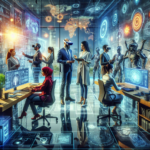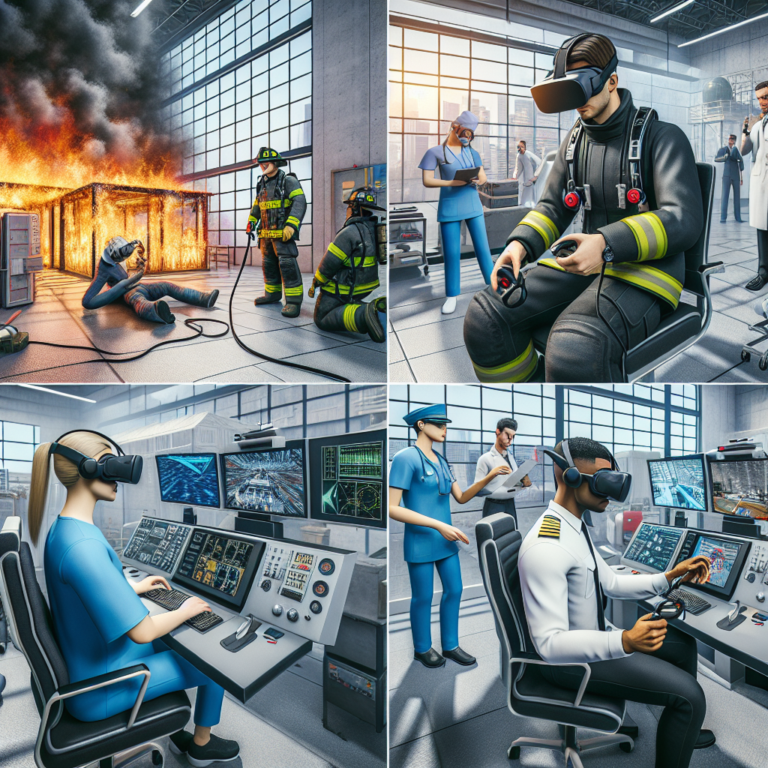Transforming Training: The Essential Role of VR in High-Risk Professions 🚀
Introduction: The New Age of Training
As we dive deeper into the 21st century, technology continues to reshape various sectors, and training methods are no exception. Virtual Reality (VR) has emerged as a revolutionary tool, particularly for high-risk professions such as healthcare, firefighting, aviation, and construction. Imagine a world where aspiring paramedics, pilots, or firefighters honed their skills in a lifelike, controlled environment, free from real-world consequences. In this blog post, we explore how VR training programs could become essential for high-risk professions, enhancing safety and efficiency like never before.
Why VR Training? The Benefits Speak Volumes!
The integration of VR into training programs offers numerous advantages:
- Realistic Simulations: VR provides an immersive experience that mirrors real-life situations. Trainees can practice scenarios that are too dangerous or impractical to replicate in traditional training.
- Immediate Feedback: VR systems can analyze performance in real-time, allowing trainees to receive instant feedback and make necessary adjustments on-the-fly.
- Cost-Effective: While initial investments in VR technology may be high, the long-term savings on training equipment, materials, and personnel are undeniable.
- Accessibility: VR can be accessed from various locations, eliminating geographical constraints and facilitating widespread training opportunities.
- Reduced Anxiety: Engaging in simulated high-pressure situations can help trainees build confidence before they face them in real life.
High-Risk Professions Leveraging VR Training
1. Healthcare: Training the Next Generation of Medical Professionals
In the medical field, VR training programs are already making waves. Medical students and professionals can engage in surgeries, patient interactions, and emergency response scenarios without putting lives at risk. Here’s how VR is revolutionizing healthcare training:
- Surgical Training: VR enables aspiring surgeons to practice intricate procedures repeatedly, allowing them to build muscle memory before operating on real patients.
- Patient Interaction: VR can simulate complex patient interactions, helping healthcare professionals develop their communication skills and bedside manner.
- Emergency Response Training: First responders can simulate crisis scenarios, improving their ability to handle emergencies effectively when they arise.
2. Aviation: Soaring to New Heights with VR
In the aviation industry, flight simulators have been in use for decades, but VR takes this concept to the next level. Pilots can experience a fully immersive cockpit environment, honing their skills under various flight conditions and emergencies. Key benefits include:
- Comprehensive Flight Training: Pilots can practice takeoffs, landings, and emergency procedures in environments that mimic real-world scenarios.
- Multi-Person Training: Multiple trainees can work together in a VR environment, practicing teamwork and communication during crises.
- Cost Savings: VR flight training significantly reduces operational costs associated with conventional training aircraft and fuel.
3. Firefighting: Battling Flames Virtually
The life of a firefighter is unpredictable and fraught with danger. VR training allows these brave professionals to face simulated fires and hazardous situations without putting their lives on the line. Here’s how VR enhances firefighter training:
- Hazard Recognition: Trainees can learn to identify dangerous situations and environmental hazards in a safe setting.
- Stress Management: Simulating high-stress scenarios can help firefighters develop coping mechanisms for actual emergencies.
- Team Coordination: VR exercises teach firefighters how to communicate and work effectively as a team, which is critical during emergencies.
4. Construction: Building Skills Safely
The construction industry is known for its high-risk environment. VR training can significantly enhance safety protocols and skill levels among workers. The benefits of integrating VR in construction training include:
- Safety Training: Trainees can engage in simulated construction environments to practice safety protocols and learn to recognize potential hazards.
- Equipment Operation: VR allows for hands-on practice with heavy machinery without the associated risks of real-world operation.
- Project Management: Workers can simulate managing large-scale projects, understanding logistics and teamwork in a controlled setting.
Implementing VR Training: Overcoming Challenges
While the advantages of VR training are clear, implementation does come with its challenges. Organizations must consider the following:
- Initial Costs: The upfront investment in VR technology and software can be significant, though offset by long-term gains.
- Technical Requirements: Ensuring all trainees have access to the necessary equipment and software is essential for widespread success.
- Tailored Training Programs: Customizing VR simulations to suit specific industry needs requires collaboration between experts and developers.
The Future: A VR Training Landscape
The future of VR training programs in high-risk professions appears promising. As technology evolves, we can expect enhancements in realism, interactivity, and user-friendliness. Companies investing in VR training today will likely see a significant return on their investment through improved safety and efficiency.
As we imagine a world where VR training becomes standard practice, the benefits will not only help professionals excel in their roles but will also ensure safer environments for everyone. The potential is immense, and as industries continue to embrace technology, the future of high-risk training is undoubtedly bright! 🌟




0 Comments